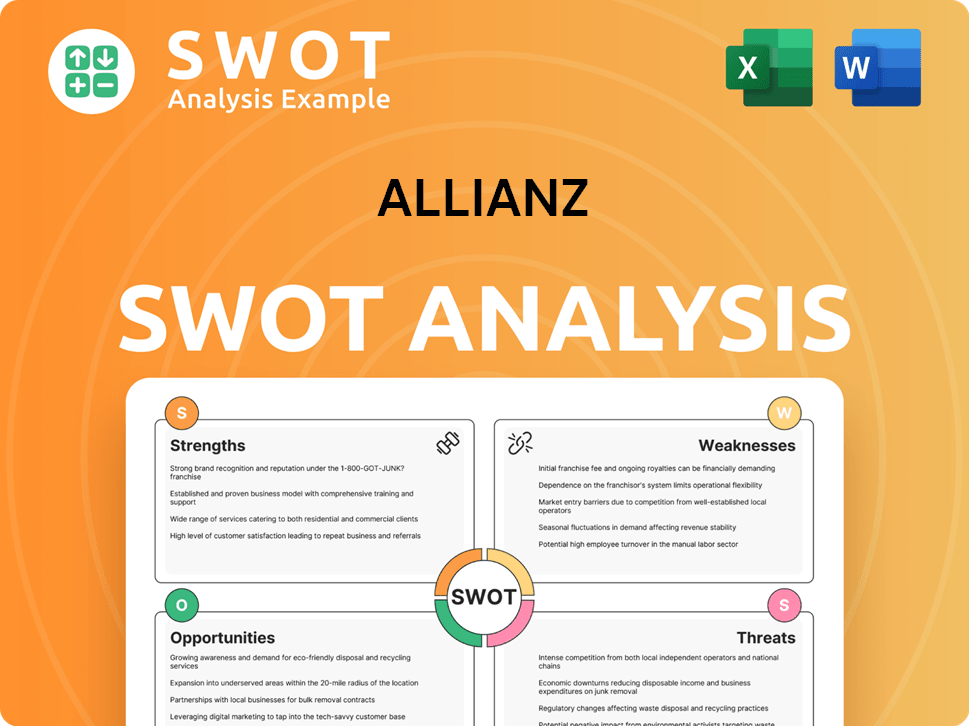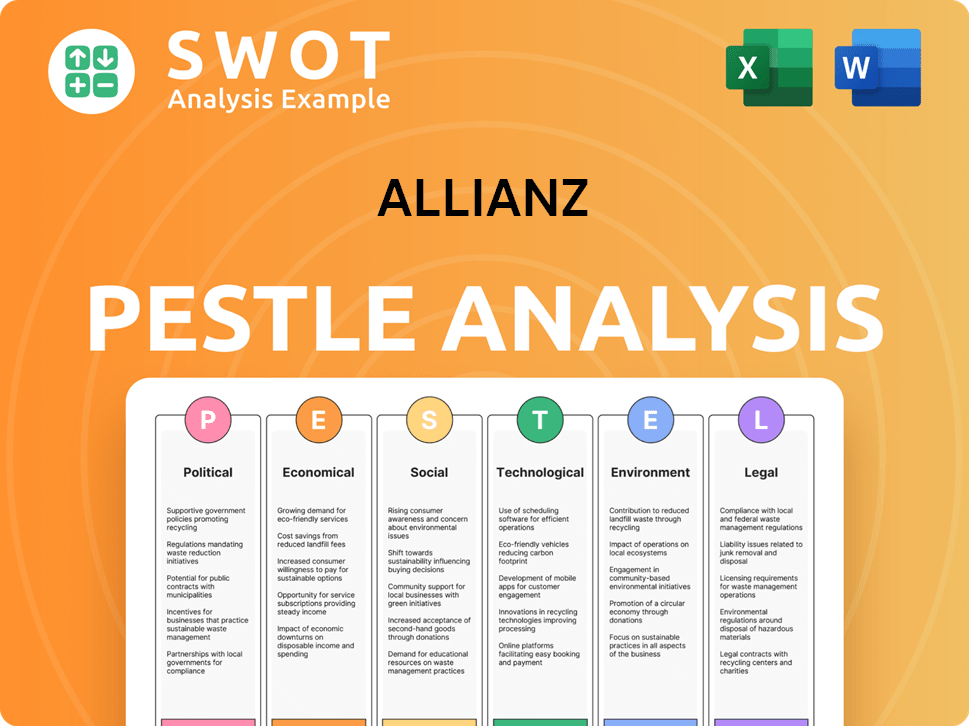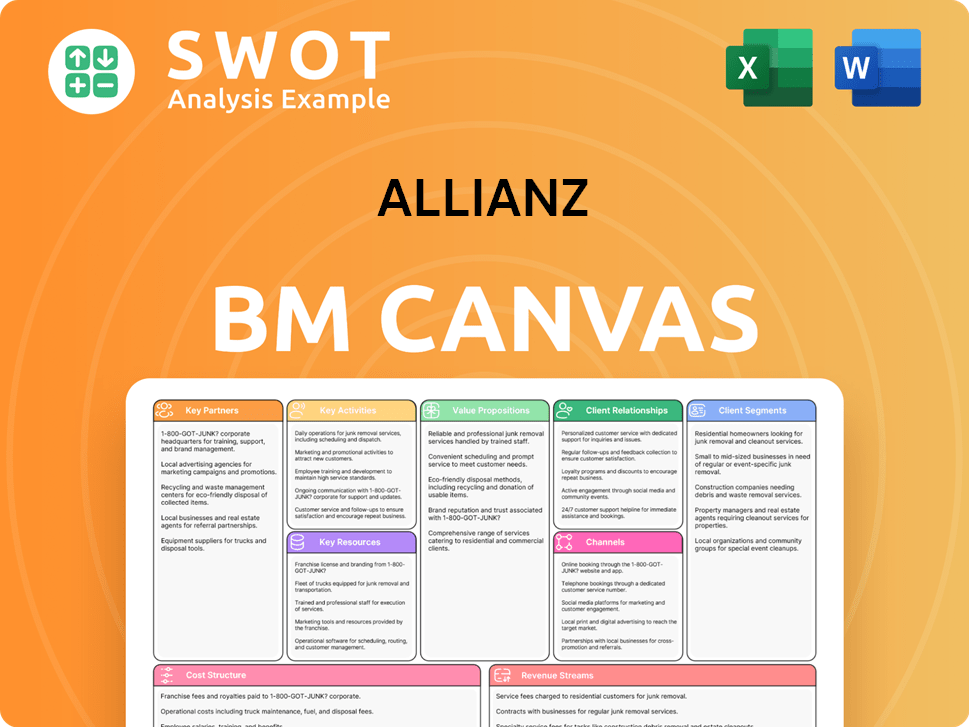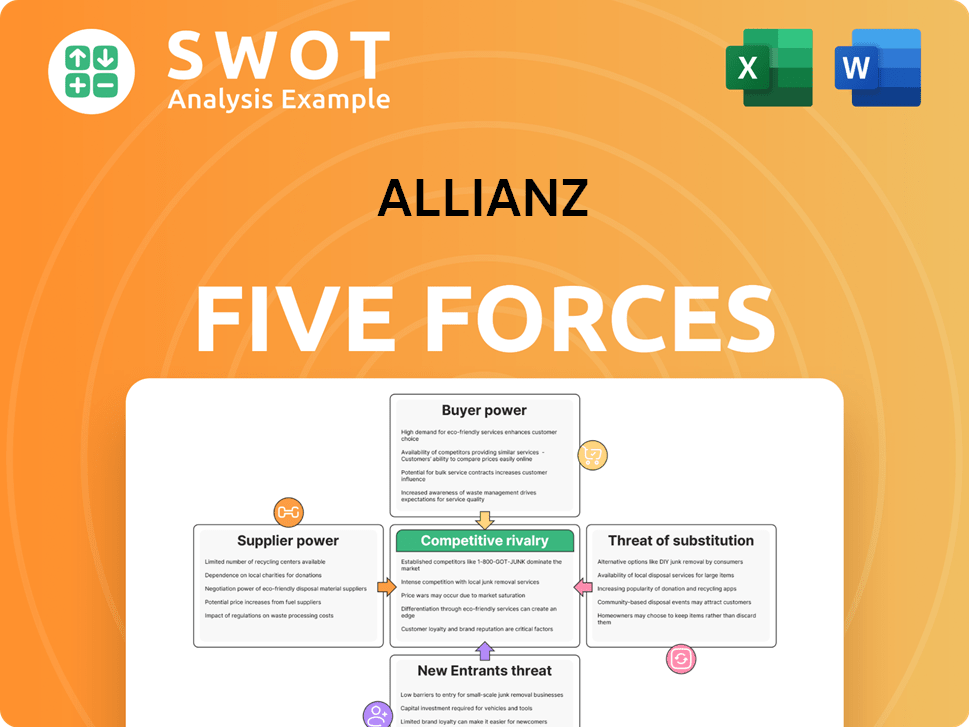Allianz Bundle
How did Allianz become a global financial powerhouse?
From its inception in 1890 in Berlin, Allianz SE has charted an extraordinary course, evolving from a German insurance provider to a global financial services giant. Its early focus on accident and transport insurance reflected a keen understanding of the needs of a rapidly industrializing Europe. This strategic foresight laid the foundation for its international expansion and enduring legacy.

The Allianz SWOT Analysis reveals the strategic decisions and pivotal moments that have shaped the Allianz company into what it is today. Understanding the brief history of Allianz insurance company provides critical insights into the company's resilience and adaptability. This exploration will uncover key milestones, challenges, and the evolution of Allianz's global footprint, from its early years and development to its current status as a leading force in the financial market.
What is the Allianz Founding Story?
The story of the Allianz company began on February 5, 1890, in Berlin. The founders, Carl von Thieme and Wilhelm von Finck, envisioned an insurance company suited to the needs of a rapidly industrializing Germany.
Their goal was to provide essential insurance coverage for the growing industrial and shipping sectors. This marked the beginning of what would become a global insurance and financial services giant.
Allianz was established to address the insurance needs of a growing industrial economy.
- The company's initial focus was on accident and transport insurance.
- The name 'Allianz,' meaning 'alliance,' was chosen to emphasize collective protection.
- Funding came from a consortium of banks and industrial investors.
The Marketing Strategy of Allianz has evolved significantly since its inception. The company's early success was built on providing essential insurance products.
In its early years, Allianz focused on accident and transport insurance, crucial for the expanding industrial and shipping sectors. This focus helped the company establish a strong foothold in the market.
The initial funding secured from banks and industrialists provided a solid foundation for Allianz. This early backing was critical for establishing the company's credibility and navigating the competitive insurance market.
Allianz SWOT Analysis
- Complete SWOT Breakdown
- Fully Customizable
- Editable in Excel & Word
- Professional Formatting
- Investor-Ready Format

What Drove the Early Growth of Allianz?
The early years of the Allianz company were characterized by strategic expansion and diversification. This period saw the company broaden its insurance offerings and extend its reach beyond its initial markets. These early moves set the stage for Allianz to become a major player in the global insurance industry.
Following its founding, Allianz quickly diversified its product line. In 1893, the company added fire insurance to its portfolio, responding to the growing need for property protection. This expansion was followed by marine insurance, which catered to the increasing maritime trade, demonstrating a proactive approach to market demands.
The company's ambitions extended beyond Germany. In 1900, Allianz established its first foreign branch in London, marking a significant step in its global expansion strategy. This was followed by entry into other European markets, including the Netherlands and Belgium, solidifying its presence in key financial centers.
A pivotal moment came in 1913 with the acquisition of Frankfurter Allgemeine Versicherungs AG, boosting its market share in Germany. The company also introduced new insurance lines, such as motor vehicle insurance in 1905, reflecting its ability to adapt to emerging market needs. By the 1920s, Allianz was a leading insurer in Germany.
Leadership transitions during these formative years were focused on professionalizing operations and solidifying its market position. The company's strategic decisions during this phase reflected a keen understanding of market needs and a proactive approach to capturing new opportunities. The market reception to Allianz's comprehensive offerings was largely positive, as its policies provided much-needed security in an era of rapid economic and social change. For more details, you can also explore the Allianz history.
Allianz PESTLE Analysis
- Covers All 6 PESTLE Categories
- No Research Needed – Save Hours of Work
- Built by Experts, Trusted by Consultants
- Instant Download, Ready to Use
- 100% Editable, Fully Customizable

What are the key Milestones in Allianz history?
The Allianz history is marked by significant achievements and strategic pivots that have shaped its trajectory as a leading global insurance and financial services provider. From its early roots in Germany to its current global presence, the Allianz company has consistently adapted to changing market dynamics and economic conditions. This adaptability has been crucial in navigating both periods of growth and times of adversity, reinforcing its position in the industry.
| Year | Milestone |
|---|---|
| 1890 | Founded in Berlin, Germany, marking the beginning of the Allianz Group. |
| Early 1900s | Expanded its operations internationally, establishing a presence in various European countries. |
| Post-World War II | Played a key role in the reconstruction of Germany, demonstrating resilience and commitment to its home market. |
| 1985 | Acquired the Dresdner Bank, diversifying its financial services portfolio. |
| 2000s | Expanded its global footprint through strategic acquisitions and partnerships, including entering the U.S. market. |
| 2008 | Navigated the global financial crisis, implementing strategic restructuring and capital strengthening measures. |
| 2020s | Continued to focus on digital transformation and sustainable business practices, adapting to evolving market demands. |
Allianz has been at the forefront of innovation in the insurance sector. A notable innovation was its early adoption of actuarial science and risk management techniques, setting industry standards for underwriting and pricing. The company also pioneered the concept of 'all-in-one' insurance policies, simplifying coverage for consumers and enhancing customer experience.
Early adoption of sophisticated risk assessment methods allowed for more accurate pricing and efficient claims management. This set a benchmark for the German insurance industry and beyond.
Simplified insurance products that combined multiple coverages into a single policy, making it easier for customers to understand and manage their insurance needs. This approach improved customer satisfaction.
Significant investments in digital platforms and mobile applications to enhance customer experience and operational efficiency. This included online portals for policy management and claims processing.
Forming alliances with leading industrial firms and other financial institutions to expand market reach and offer comprehensive financial solutions. These partnerships were key to market penetration.
Expanding beyond traditional insurance to include asset management, wealth management, and other financial services to cater to a broader customer base. This increased revenue streams.
Integrating Environmental, Social, and Governance (ESG) factors into investment strategies and business operations, reflecting a commitment to sustainability. This appeals to socially conscious investors.
Throughout its history, Allianz has faced numerous challenges. The global financial crisis of 2008 necessitated strategic restructuring and capital strengthening to maintain financial stability. Competitive pressures from new market entrants and evolving regulatory landscapes have consistently pushed the company to adapt and innovate.
The 2008 financial crisis and other economic downturns required strategic restructuring and capital strengthening to maintain financial stability and protect stakeholders. These events tested its resilience.
Increased competition from both established players and new market entrants, including InsurTech companies, has driven the need for continuous innovation and adaptation to maintain market share. This required agility.
Evolving regulatory landscapes, such as Solvency II, have demanded significant investments in compliance and risk management, impacting operational costs and strategic decisions. Compliance is crucial.
The rapid pace of technological change and the need to integrate new technologies, such as AI and blockchain, into existing systems has presented both opportunities and challenges. This requires expertise.
Navigating product failures and internal crises, such as those related to investment strategies or compliance issues, has required strategic pivots, including divesting non-core assets or reorganizing business units. This demands decisive action.
Managing risks associated with geopolitical instability, economic downturns, and regional economic fluctuations, which require a diversified global portfolio and robust risk management strategies. This demands foresight.
In 2024, Allianz reported a strong financial performance, with total revenues reaching approximately €152.7 billion. The company's operating profit was around €14.7 billion, demonstrating its ability to generate solid returns despite economic uncertainties. Furthermore, Allianz has consistently emphasized its commitment to sustainability, integrating ESG factors into its investment strategies and business operations. For a deeper dive into the Allianz company's strategy, consider reading about the Growth Strategy of Allianz.
Allianz Business Model Canvas
- Complete 9-Block Business Model Canvas
- Effortlessly Communicate Your Business Strategy
- Investor-Ready BMC Format
- 100% Editable and Customizable
- Clear and Structured Layout

What is the Timeline of Key Events for Allianz?
The Allianz company has a rich history, marked by strategic expansions and innovations. Founded in Berlin in 1890, it quickly grew into a global insurance and asset management leader. Over the years, Allianz adapted to changing market dynamics, expanding its reach and services worldwide.
| Year | Key Event |
|---|---|
| 1890 | Allianz was founded in Berlin, Germany. |
| 1900 | The company established its first foreign branch in London. |
| 1905 | Allianz introduced motor vehicle insurance, expanding its product offerings. |
| 1913 | Allianz acquired Frankfurter Allgemeine Versicherungs AG. |
| 1949 | Headquarters were relocated to Munich after World War II. |
| 1959 | Unit-linked life insurance policies were introduced. |
| 1985 | The company was listed on the Frankfurt Stock Exchange. |
| 1998 | Allianz acquired Assurance Générale de France (AGF). |
| 2001 | Pacific Investment Management Company (PIMCO) was acquired, boosting asset management capabilities. |
| 2008 | Allianz navigated the global financial crisis with strategic capital measures. |
| 2015 | The company launched its digital agenda, accelerating digital transformation. |
| 2020 | Allianz celebrated its 130th anniversary, emphasizing sustainability and customer-centricity. |
| 2024 | Allianz continues to focus on strategic growth areas like renewable energy insurance and digital health solutions. |
Allianz is actively pursuing growth in key areas, including renewable energy insurance and digital health solutions. The company is investing in these sectors to capitalize on emerging market opportunities. This strategic focus aligns with global trends and customer needs, ensuring long-term sustainability and relevance.
The company is leveraging artificial intelligence and data analytics to personalize insurance products. This includes enhancing risk assessment and streamlining claims processes. Digital transformation is a key initiative, aiming to improve customer experience and operational efficiency. These efforts support the company's goal of becoming a leading digital insurer.
Allianz is expanding its global footprint, particularly in Asia and Africa, recognizing the immense potential in underserved markets. The company aims to strengthen its position in corporate and specialty insurance. This expansion strategy is supported by a focus on innovation and customer satisfaction.
The asset management arm of Allianz is focused on the growing demand for sustainable investment solutions. This strategic direction reflects a commitment to environmental, social, and governance (ESG) factors. The company aims to offer innovative and responsible investment products to meet evolving investor preferences.
Allianz Porter's Five Forces Analysis
- Covers All 5 Competitive Forces in Detail
- Structured for Consultants, Students, and Founders
- 100% Editable in Microsoft Word & Excel
- Instant Digital Download – Use Immediately
- Compatible with Mac & PC – Fully Unlocked

Related Blogs
- What is Competitive Landscape of Allianz Company?
- What is Growth Strategy and Future Prospects of Allianz Company?
- How Does Allianz Company Work?
- What is Sales and Marketing Strategy of Allianz Company?
- What is Brief History of Allianz Company?
- Who Owns Allianz Company?
- What is Customer Demographics and Target Market of Allianz Company?
Disclaimer
All information, articles, and product details provided on this website are for general informational and educational purposes only. We do not claim any ownership over, nor do we intend to infringe upon, any trademarks, copyrights, logos, brand names, or other intellectual property mentioned or depicted on this site. Such intellectual property remains the property of its respective owners, and any references here are made solely for identification or informational purposes, without implying any affiliation, endorsement, or partnership.
We make no representations or warranties, express or implied, regarding the accuracy, completeness, or suitability of any content or products presented. Nothing on this website should be construed as legal, tax, investment, financial, medical, or other professional advice. In addition, no part of this site—including articles or product references—constitutes a solicitation, recommendation, endorsement, advertisement, or offer to buy or sell any securities, franchises, or other financial instruments, particularly in jurisdictions where such activity would be unlawful.
All content is of a general nature and may not address the specific circumstances of any individual or entity. It is not a substitute for professional advice or services. Any actions you take based on the information provided here are strictly at your own risk. You accept full responsibility for any decisions or outcomes arising from your use of this website and agree to release us from any liability in connection with your use of, or reliance upon, the content or products found herein.